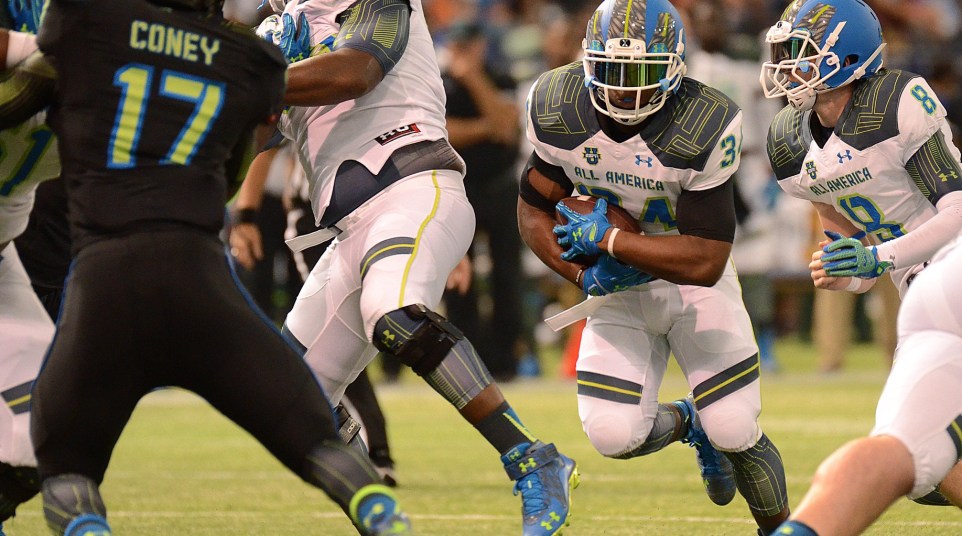Which SEC freshman will rush for 1,000 yards in 2015?
Seven different SEC freshmen have rushed for 1,000 yards in the last five seasons.
Not surprisingly, all of them became instant stars.
Johnny Manziel won the Heisman Trophy while leading the SEC in rushing in ’14. Todd Gurley and Marcus Lattimore got selected higher than anticipated in the NFL draft despite severe knee injuries at the end of their college careers. T.J. Yeldon was a surprise second-round draft choice this year as well.
Nick Chubb, Leonard Fournette and Alex Collins remain in the SEC this year, part of an exciting collection of running back talent.
SEC PLAYERS WITH 1,000 RUSHING YARDS AS A FRESHMAN, LAST FIVE YEARS
| Player | Team | Yards | Year |
|---|---|---|---|
| Nick Chubb | Georgia | 1,547 | 2014 |
| Johnny Manziel | Texas A&M | 1,410 | 2012 |
| Todd Gurley | Georgia | 1,385 | 2012 |
| Marcus Lattimore | South Carolina | 1,197 | 2010 |
| T.J. Yeldon | Alabama | 1,108 | 2012 |
| Leonard Fournette | LSU | 1,034 | 2014 |
| Alex Collins | Arkansas | 1,036 | 2013 |
It’s very difficult to project any SEC running back to top 1,000 yards as a freshman this year. But recent history tells us there’s a good chance it will happen, as it has in four of the last five seasons.
No one projected that Chubb, buried on the depth chart behind Gurley, Keith Marshall and others before the season, would become an All-SEC running back in ’14.
Recently, we ranked the SEC’s five best incoming freshmen running backs.
1. Damien Harris, Alabama
2. Derrius Guice, LSU
3. Jordan Scarlett, Florida
4. Eric Swinney, Ole Miss
5. Desherrius Flowers, Alabama
Let’s look at a few factors that must come together for a running back to have a shot at the benchmark as an SEC freshman, considering those five players.
OPPORTUNITY
Helps: Scarlett
Hurts: Harris, Guice, Swinney, Flowers
There’s no obvious freshmen who should storm onto campus and immediately represent a big-time threat to become the team’s starter, like Fournette in ’14. But it may help Scarlett that there’s a new coaching staff in Gainesville, Fla. The Gators are desperate to jump start the offense, so if the coaches feel he’s more talented than Kelvin Taylor and Adam Lane, he’s got a chance to earn opportunities right away. At Alabama, at least one of the two players should get significant time, but still must play behind Derrick Henry and Kenyan Drake. Guice must compete with Darrel Williams and Nick Brossette for Fournette’s scraps, while Jaylen Walton is the clear-cut starter in Oxford.
ELITE NATURAL ABILITY
Helps: Harris
Hurts: Swinney
The word “elite” here means more than good. I’m talking about jaw-dropping natural talent. The kind that catches the attention of NFL scouts immediately. Even in the SEC, that’s a rare trait for a true freshman. We can’t say that Harris has that kind of ability for sure — he has yet to practice for the Crimson Tide. Ole Miss coach Hugh Freeze recently characterized Swinney as a player who “probably does not have the top‐end speed that a few in the nation have.” He’s added weight to his frame, but it doesn’t sound like he has once-in-a-decade type talent for the Rebels.
GREAT OFFENSIVE LINE PLAY
Helps: Guice
Hurts: Scarlett, Swinney
Florida’s offensive line woes are well-documented. The Gators should trot out four first-time starters on the offensive line this fall, including some true freshmen. But the Ole Miss line was no great shakes last season, even with potential first-round pick Laremy Tunsil. The Rebels running backs were more talented than the team’s 4.3 yards per carry indicated (11th in the SEC). But the line allowed too many defenders to penetrate and didn’t open up enough holes.
RUN-ORIENTED OFFENSE
Helps: Guice
Hurts: None
Almost every SEC team could be considered “run-oriented” to an extent. But we’re talking Arkansas or Georgia levels here. Alabama (offensive coordinator Lane Kiffin) and Florida (coach Jim McElwain) both seem to be moving toward passing the ball more often. Ole Miss doesn’t pound the ball on the ground as often as most SEC teams. But LSU, with plenty of questions in the passing game, should rely on the backfield pretty often.
CONCLUSION
It may take a significant injury or two to some of the SEC’s premier returning backs for some of these talented freshmen to get enough carries to threaten 1,000 yards. That’s not something for which to root. But if Henry were to go down early in the year, Harris would become a candidate to challenge that stat. It’s tough to predict exactly how Florida’s offense will look behind that line and in McElwain’s first year. We don’t even know the starting quarterback. But Scarlett may have the best chance as it stands now to make an impact in 2015.
Despite the recent history, I don’t think we’ll see a 1,000-yard rusher this fall among the freshmen in the ’15 SEC recruiting class.

